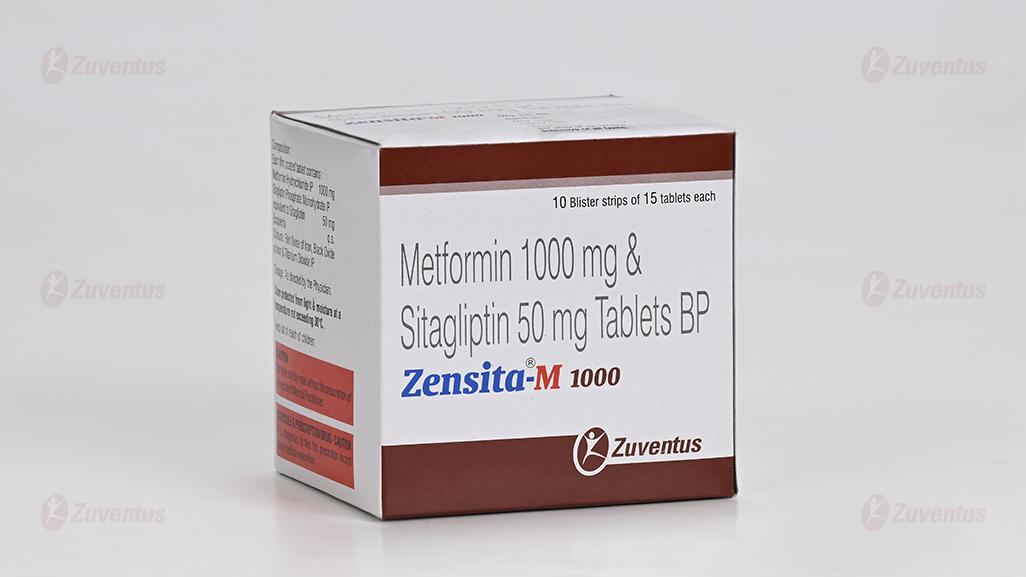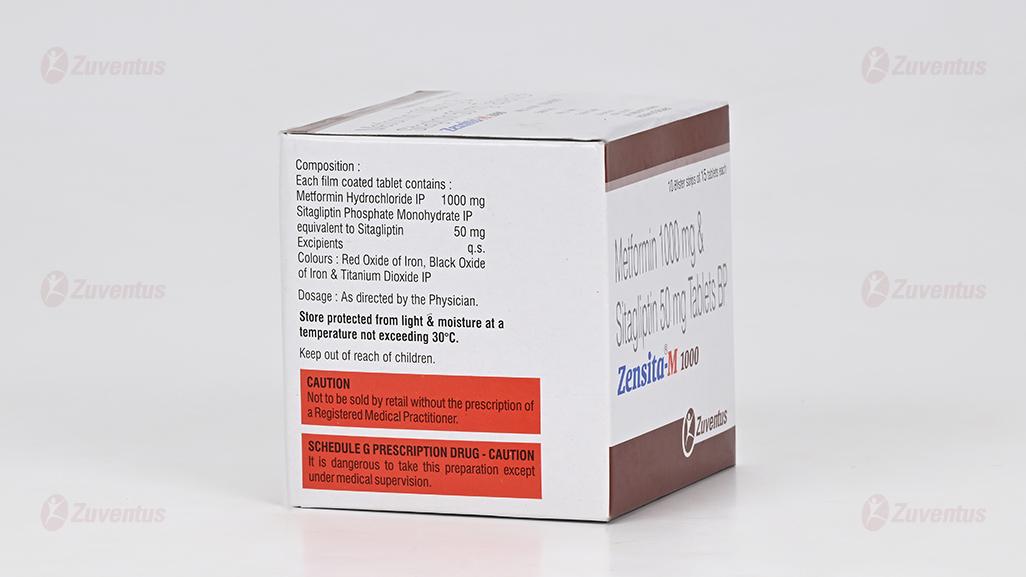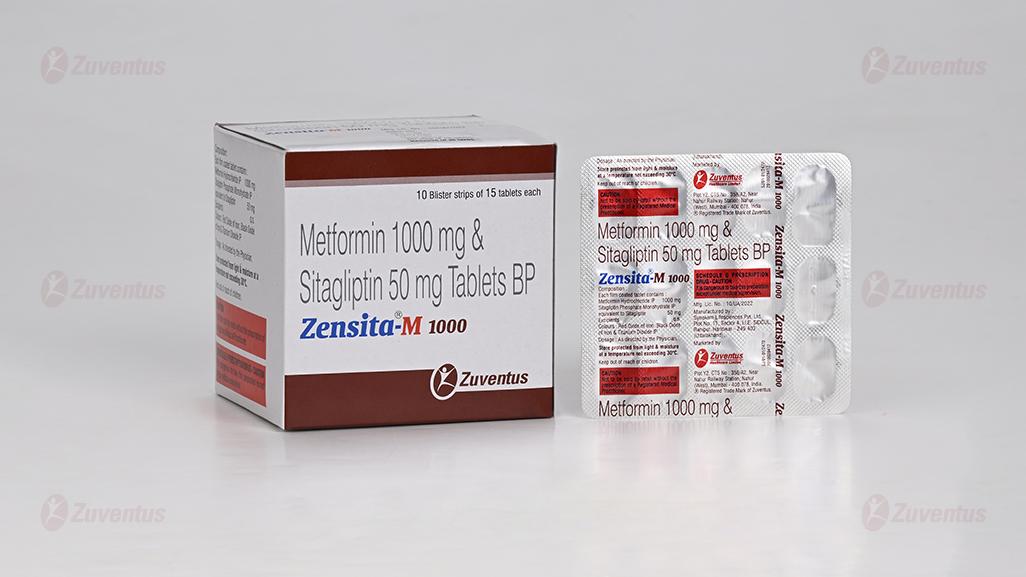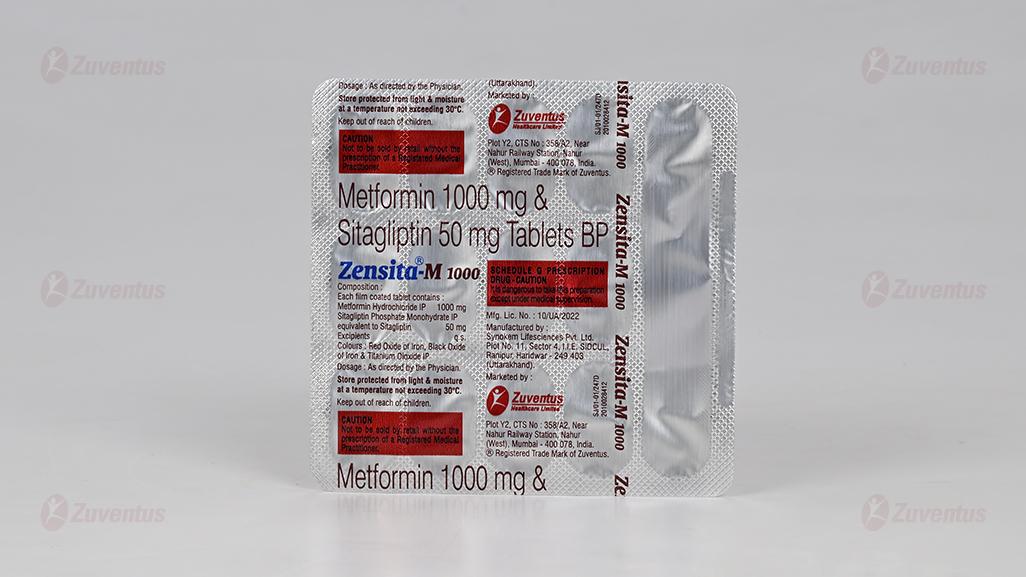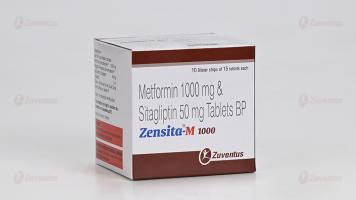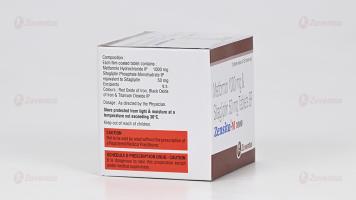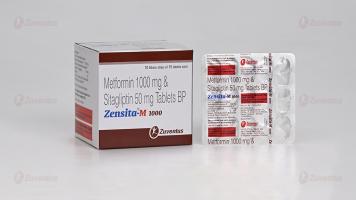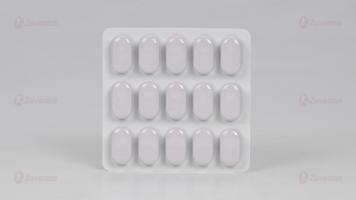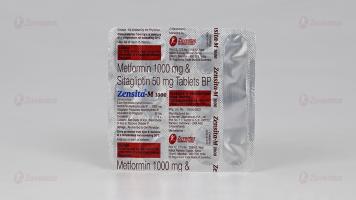Zensita M 1000 Tablets
Therapy Area
Anti-diabetic
1.0 Generic name
Sitagliptin & Metformin Hydrochloride Tablets
2.0 Qualitative and quantitative composition
Zensita M 500
Each film coated tablet contains :
Sitagliptin Phosphate Monohydrate IP
equivalent to Sitagliptin 50 mg
Metformin Hydrochloride IP 500 mg
Colours : Red Oxide of Iron & Titanium Dioxide IP
Zensita M 1000
Each film coated tablet contains :
Sitagliptin Phosphate Monohydrate IP
equivalent to Sitagliptin 50 mg
Metformin Hydrochloride IP 1000 mg
Colours : Red Oxide of Iron, Black Oxide of Iron & Titanium Dioxide IP
3.0 Dosage form and strength
Film coated tablet
4.0 Clinical particulars
4.1 Therapeutic indication
As adjunct to diet and exercise to improve glycemic control in patients with type-II diabetes mellitus.
4.2 Posology and method of administration
The dosage of Zensita M should be individualized on the basis of the patient’s current regimen, effectiveness, and tolerability while not exceeding the maximum recommended daily dose of 100 mg Sitagliptin and 2000 mg Metformin. Initial combination therapy or maintenance of combination therapy should be individualized and left to the discretion of the health care provider. Zensita M should generally be given twice daily with meals, with gradual dose escalation, to reduce the gastrointestinal (GI) side effects due to Metformin.
The starting dose of Zensita M should be based on the patient’s current regimen. Zensita M should be given twice daily with meals. The following doses are available :
50 mg Sitagliptin / 500 mg Metformin Hydrochloride 50 mg Sitagliptin / 1000 mg Metformin Hydrochloride. The recommended starting dose in patients not currently treated with Metformin is 50 mg Sitagliptin / 500 mg Metformin Hydrochloride twice daily, with gradual dose escalation recommended to reduce gastrointestinal side effects associated with Metformin. The starting dose in patients already treated with Metformin should provide Sitagliptin dosed as 50 mg twice daily (100 mg total daily dose) and the dose of Metformin already being taken. For patients taking Metformin 850 mg twice daily, the recommended starting dose of Zensita M is 50 mg Sitagliptin / 1000 mg Metformin Hydrochloride twice daily.
Patients treated with an insulin secretagogue or insulin
Co-administration of Zensita M with an insulin secretagogue (e.g., Sulfonylurea) or insulin may require lower doses of the insulin secretagogue or insulin to reduce the risk of hypoglycemia. No studies have been performed specifically examining the safety and efficacy of Zensita M in patients previously treated with other oral antihyperglycemic agents and switched to Zensita M. Any change in therapy of type 2 diabetes should be undertaken with care and appropriate monitoring as changes in glycemic control can occur.
4.3 Contraindications
- Renal disease or renal dysfunction, e.g., as suggested by serum creatinine levels ≥1.5 mg/dL [males], ≥1.4 mg/dL [females] or abnormal creatinine clearance which may also result from conditions such as cardiovascular collapse (shock), acute myocardial infarction, and septicaemia.
- Acute or chronic metabolic acidosis, including diabetic ketoacidosis, with or without coma.
- History of a serious hypersensitivity reaction to Zensita Mor Sitagliptin (one of the components of Zensita M), such as anaphylaxis or angioedema.
- Zensita M should be temporarily discontinued in patients undergoing radiologic studies involving intravascular administration of iodinated contrast materials, because use of such products may result in acute alteration of renal function.
4.4 Special warnings and precautions for use
General
Zensita Mshould not be used in patients with type 1 diabetes and must not be used for the treatment of diabetic ketoacidosis.
Acute pancreatitis
Use of DPP-4 inhibitors has been associated with a risk of developing acute pancreatitis. Patients should be informed of the characteristic symptom of acute pancreatitis: persistent, severe abdominal pain. Resolution of pancreatitis has been observed after discontinuation of Sitagliptin (with or without supportive treatment), but very rare cases of necrotising or haemorrhagic pancreatitis and/or death have been reported. If pancreatitis is suspected, Zensita M and other potentially suspect medicinal products should be discontinued; if acute pancreatitis is confirmed, Zensita M should not be restarted. Caution should be exercised in patients with a history of pancreatitis.
Lactic acidosis
Lactic acidosis, a rare but serious metabolic complication, most often occurs at acute worsening of renal function or cardiorespiratory illness or sepsis. Metformin accumulation occurs at acute worsening of renal function and increases the risk of lactic acidosis. In case of dehydration (severe vomiting, diarrhoea, fever or reduced fluid intake), Metformin should be temporarily discontinued and contact with a health care professional is recommended.
Medicinal products that can acutely impair renal function (such as antihypertensives, diuretics and NSAIDs) should be initiated with caution in Metformin-treated patients. Other risk factors for lactic acidosis are excessive alcohol intake, hepatic insufficiency, inadequately controlled diabetes, ketosis, prolonged fasting and any conditions associated with hypoxia, as well as concomitant use of medicinal products that may cause lactic acidosis.
Patients and/or care-givers should be informed of the risk of lactic acidosis. Lactic acidosis is characterised by acidotic dyspnoea, abdominal pain, muscle cramps, asthenia and hypothermia followed by coma. In case of suspected symptoms, the patient should stop taking Metformin and seek immediate medical attention. Diagnostic laboratory findings are decreased blood pH (< 7.35), increased plasma lactate levels (> 5 mmol/L) and an increased anion gap and lactate/pyruvate ratio.
Renal function
GFR should be assessed before treatment initiation and regularly thereafter. Zensita M is contraindicated in patients with GFR < 30 mL/min and should be temporarily discontinued during conditions with the potential to alter renal function
Hypoglycaemia
Patients receiving Zensita M in combination with a Sulphonylurea or with Insulin may be at risk for hypoglycaemia. Therefore, a reduction in the dose of the sulphonylurea or insulin may be necessary.
Hypersensitivity reactions
Post-marketing reports of serious hypersensitivity reactions in patients treated with Sitagliptin have been reported. These reactions include anaphylaxis, angioedema, and exfoliative skin conditions including Stevens-Johnson syndrome. Onset of these reactions occurred within the first 3 months after initiation of treatment with Sitagliptin, with some reports occurring after the first dose. If a hypersensitivity reaction is suspected, Zensita Mshould be discontinued, other potential causes of the event should be assessed, and alternative treatment for diabetes should be instituted.
Bullous pemphigoid
There have been post-marketing reports of bullous pemphigoid in patients taking DPP-4 inhibitors including Sitagliptin. If bullous pemphigoid is suspected, Zensita Mshould be discontinued.
Surgery
Zensita M must be discontinued at the time of surgery under general, spinal or epidural anaesthesia. Therapy may be restarted no earlier than 48 hours following surgery or resumption of oral nutrition and provided that renal function has been re-evaluated and found to be stable.
Administration of iodinated contrast agent
Intravascular administration of iodinated contrast agents may lead to contrast-induced nephropathy, resulting in Metformin accumulation and an increased risk of lactic acidosis. Zensita M should be discontinued prior to or at the time of the imaging procedure and not restarted until at least 48 hours after, provided that renal function has been re-evaluated and found to be stable.
Change in clinical status of patients with previously controlled type 2 diabetes
A patient with type 2 diabetes previously well controlled on Zensita M who develops laboratory abnormalities or clinical illness (especially vague and poorly defined illness) should be evaluated promptly for evidence of ketoacidosis or lactic acidosis. Evaluation should include serum electrolytes and ketones, blood glucose and, if indicated, blood pH, lactate, pyruvate, and Metformin levels. If acidosis of either form occurs, treatment must be stopped immediately and other appropriate corrective measures initiated.
4.5 Drugs interactions
Co-administration of multiple doses of Sitagliptin (50 mg twice daily) and Metformin (1,000 mg twice daily) did not meaningfully alter the pharmacokinetics of either Sitagliptin or Metformin in patients with type 2 diabetes. Pharmacokinetic drug interaction studies with Zensita M have not been performed; however, such studies have been conducted with the individual active substances, Sitagliptin and Metformin. Concomitant use not recommended.
Alcohol
Alcohol intoxication is associated with an increased risk of lactic acidosis, particularly in cases of fasting, malnutrition or hepatic impairment.
Iodinated contrast agents
Zensita M must be discontinued prior to or at the time of the imaging procedure and not restarted until at least 48 hours after, provided that renal function has been re-evaluated and found to be stable.
Combinations requiring precautions for use
Some medicinal products can adversely affect renal function, which may increase the risk of lactic acidosis, e.g. NSAIDs, including selective Cyclo-oxygenase (COX) II inhibitors, ACE inhibitors, angiotensin II receptor antagonists and diuretics, especially loop diuretics. When starting or using such products in combination with Metformin, close monitoring of renal function is necessary. Concomitant use of drugs that interfere with common renal tubular transport systems involved in the renal elimination of Metformin (e.g., Organic Cationic Transporter-2 [OCT2] / Multidrug And Toxin Extrusion [MATE] inhibitors such as Ranolazine, Vandetanib, Dolutegravir, and cimetidine) could increase systemic exposure to Metformin and may increase the risk for lactic acidosis. Consider the benefits and risks of concomitant use. Close monitoring of glycaemic control, dose adjustment within the recommended posology and changes in diabetic treatment should be considered when such products are co-administered.
Glucocorticoids (given by systemic and local routes) beta-2-agonists, and diuretics have intrinsic hyperglycaemic activity. The patient should be informed and more frequent blood glucose monitoring performed, especially at the beginning of treatment with such medicinal products. If necessary, the dose of the anti-hyperglycaemic medicinal product should be adjusted during therapy with the other medicinal product and on its discontinuation. ACE-inhibitors may decrease the blood glucose levels. If necessary, the dose of the anti-hyperglycaemic medicinal product should be adjusted during therapy with the other medicinal product and on its discontinuation.
Effects of other medicinal products on Sitagliptin
In vitro and clinical data described below suggest that the risk for clinically meaningful interactions following co-administration of other medicinal products is low. In vitro studies indicated that the primary enzyme responsible for the limited metabolism of Sitagliptin is CYP3A4, with contribution from CYP2C8. In patients with normal renal function, metabolism, including via CYP3A4, plays only a small role in the clearance of Sitagliptin. Metabolism may play a more significant role in the elimination of Sitagliptin in the setting of severe renal impairment or end-stage renal disease (ESRD). For this reason, it is possible that potent CYP3A4 inhibitors (i.e., Ketoconazole, Itraconazole, Ritonavir, Clarithromycin) could alter the pharmacokinetics of Sitagliptin in patients with severe renal impairment or ESRD. The effects of potent CYP3A4 inhibitors in the setting of renal impairment have not been assessed in a clinical study. In vitro transport studies showed that Sitagliptin is a substrate for p-glycoprotein and organic anion transporter-3 (OAT3). OAT3 mediated transport of Sitagliptin was inhibited in vitro by probenecid, although the risk of clinically meaningful interactions is considered to be low. Concomitant administration of OAT3 inhibitors has not been evaluated in vivo.
Ciclosporin
A study was conducted to assess the effect of Ciclosporin, a potent inhibitor of p-glycoprotein, on the pharmacokinetics of Sitagliptin. Co-administration of a single 100 mg oral dose of Sitagliptin and a single 600 mg oral dose of Ciclosporin increased the AUC and Cmax of Sitagliptin by approximately 29% and 68%, respectively. These changes in Sitagliptin pharmacokinetics were not considered to be clinically meaningful. The renal clearance of Sitagliptin was not meaningfully altered. Therefore, meaningful interactions would not be expected with other p-glycoprotein inhibitors.
Effects of Sitagliptin on other medicinal products
Digoxin
Sitagliptin had a small effect on plasma digoxin concentrations. Following administration of 0.25 mg digoxin concomitantly with 100 mg of Sitagliptin daily for 10 days, the plasma AUC of digoxin was increased on average by 11%, and the plasma Cmax on average by 18%. No dose adjustment of digoxin is recommended. However, patients at risk of digoxin toxicity should be monitored for this when Sitagliptin and Digoxin are administered concomitantly.
In vitro data suggest that Sitagliptin does not inhibit nor induce CYP450 isoenzymes. In clinical studies, Sitagliptin did not meaningfully alter the pharmacokinetics of Metformin, Glyburide, Simvastatin, Rosiglitazone, Warfarin, or oral contraceptives, providing in vivo evidence of a low propensity for causing interactions with substrates of CYP3A4, CYP2C8, CYP2C9, and organic cationic transporter (OCT). Sitagliptin may be a mild inhibitor of p-glycoprotein in vivo
4.6 Use in special populations
Pregnancy
There are no adequate data from the use of Sitagliptin in pregnant women. Studies in animals have shown reproductive toxicity at high doses of Sitagliptin. A limited amount of data suggests the use of Metformin in pregnant women is not associated with an increased risk of congenital malformations. Animal studies with Metformin do not indicate harmful effects with respect to pregnancy, embryonic or foetal development, parturition or postnatal development.
Zensita M should not be used during pregnancy. If a patient wish to become pregnant or if a pregnancy occurs, treatment should be discontinued and the patient switched to insulin treatment as soon as possible.
Breast-feeding
No studies in lactating animals have been conducted with the combined active substances of this medicinal product. In studies performed with the individual active substances, both Sitagliptin and Metformin are excreted in the milk of lactating rats. Metformin is excreted in human milk in small amounts. It is not known whether Sitagliptin is excreted in human milk. Zensita Mmust therefore not be used in women who are breast-feeding.
Fertility
Animal data do not suggest an effect of treatment with Sitagliptin on male and female fertility. Human data are lacking.
4.7 Effects on ability to drive and use machines
Zensita M has no or negligible influence on the ability to drive and use machines. However, when driving or using machines, it should be taken into account that dizziness and somnolence have been reported with Sitagliptin. In addition, patients should be alerted to the risk of hypoglycaemia when Zensita M is used in combination with a sulphonylurea or with insulin.
4.8 Undesirable effects
There have been no therapeutic clinical trials conducted with Zensita M tablets however bioequivalence of Zensita M with co-administered Sitagliptin and Metformin has been demonstrated. Serious adverse reactions including pancreatitis and hypersensitivity reactions have been reported. Hypoglycaemia has been reported in combination with sulphonylurea and insulin.
Sitagliptin and Metformin
Table 1 : The frequency of adverse reactions identified from placebo-controlled clinical studies of Sitagliptin and Metformin alone, and postmarketing

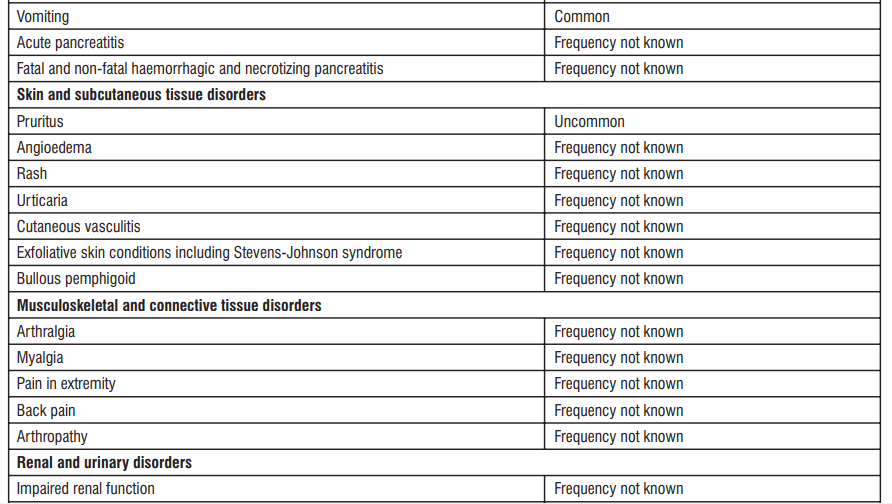

Description of selected adverse reactions
Some adverse reactions were observed more frequently in studies of combination use of Sitagliptin and Metformin with other anti-diabetic medicinal products than in studies of Sitagliptin and Metformin alone. These included hypoglycaemia (frequency very common with Sulphonylurea or Insulin), constipation (common with Sulphonylurea), peripheral oedema (common with Pioglitazone), and headache and dry mouth (uncommon with Insulin).
Sitagliptin
In monotherapy studies of Sitagliptin 100 mg once daily alone compared to placebo, adverse reactions reported were headache, hypoglycaemia, constipation, and dizziness. Among these patients, adverse events reported regardless of causal relationship to medicinal product occurring in at least 5% included upper respiratory tract infection and nasopharyngitis. In addition, osteoarthritis and pain in extremity were reported with frequency uncommon (> 0.5% higher among Sitagliptin users than that in the control group).
Metformin
Gastrointestinal symptoms were reported very commonly in clinical studies and post-marketing use of Metformin. Gastrointestinal symptoms such as nausea, vomiting, diarrhoea, abdominal pain and loss of appetite occur most frequently during initiation of therapy and resolve spontaneously in most cases. Additional adverse reactions associated with Metformin include metallic taste (common); lactic acidosis, liver function disorders, hepatitis, urticaria, erythema, and pruritus (very rare). Long-term treatment with Metformin has been associated with a decrease in Vitamin B12 absorption which may very rarely result in clinically significant Vitamin B12 deficiency (e.g., megaloblastic anaemia).
Paediatric population
In clinical trials with Zensita M in paediatric patients with type 2 diabetes mellitus aged 10 to 17 years, the profile of adverse reactions was generally comparable to that observed in adults. In paediatric patients on or not on background Insulin, Sitagliptin was associated with an increased risk of hypoglycaemia.
TECOS cardiovascular safety study
The Trial Evaluating Cardiovascular Outcomes with Sitagliptin (TECOS) included 7,332 patients treated with Sitagliptin, 100 mg daily (or 50 mg daily if the baseline eGFR was ≥ 30 and < 50 mL/min/1.73 m2), and 7,339 patients treated with placebo in the intention-to-treat population. Both treatments were added to usual care targeting regional standards for HbA1c and CV risk factors. The overall incidence of serious adverse events in patients receiving Sitagliptin was similar to that in patients receiving placebo. In the intention-to-treat population, among patients who were using insulin and/or a sulfonylurea at baseline, the incidence of severe hypoglycaemia was 2.7% in Sitagliptin-treated patients and 2.5% in placebo-treated patients; among patients who were not using insulin and/or a sulfonylurea at baseline, the incidence of severe hypoglycaemia was 1.0% in Sitagliptin-treated patients and 0.7% in placebo-treated patients. The incidence of adjudication-confirmed pancreatitis events was 0.3% in Sitagliptin-treated patients and 0.2% in placebo-treated patients.
Reporting of suspected adverse reactions
Reporting suspected adverse reactions after authorisation of the medicinal product is important. It allows continued monitoring of the benefit/risk balance of the medicinal product. Healthcare professionals are asked to report any suspected adverse reactions via email to : medico@zuventus.com Website : http://www.zuventus.co.in/safety.aspx By reporting side effects, you can help provide more information on the safety of this medicine.
4.9 Overdose
Sitagliptin
During controlled clinical trials in healthy subjects, single doses of up to 800 mg Sitagliptin were administered. Maximal mean increases in QTc of 8.0 msec were observed in one study at a dose of 800 mg Sitagliptin, a mean effect that is not considered clinically important. There is no experience with doses above 800 mg in clinical studies. In Phase I multiple-dose studies, there were no dose-related clinical adverse reactions observed with Sitagliptin with doses of up to 400 mg per day for periods of up to 28 days. In the event of an overdose, it is reasonable to employ the usual supportive measures, e.g., remove unabsorbed material from the gastrointestinal tract, employ clinical monitoring (including obtaining an electrocardiogram), and institute supportive therapy as indicated by the patient's clinical status.
Sitagliptin is modestly dialyzable. In clinical studies, approximately 13.5% of the dose was removed over a 3 to 4 hour hemodialysis session. Prolonged hemodialysis may be considered if clinically appropriate. It is not known if Sitagliptin is dialyzable by peritoneal dialysis.
Metformin hydrochloride
Overdose of Metformin Hydrochloride has occurred, including ingestion of amounts greater than 50 grams. Hypoglycemia was reported in approximately 10% of cases, but no causal association with Metformin Hydrochloride has been established. Lactic acidosis has been reported in approximately 32% of Metformin overdose cases. Metformin is dialyzable with a clearance of up to 170 mL/min under good hemodynamic conditions. Therefore, hemodialysis may be useful for removal of accumulated drug from patients in whom Metformin overdosage is suspected.
5.0 Pharmacological properties
5.1 Mechanism of action
Zensita M combines two antihyperglycemic agents with complementary mechanisms of action to improve glycemic control in patients with type 2 diabetes : Sitagliptin, a dipeptidyl peptidase-4 (DPP-4) inhibitor, and Metformin Hydrochloride, a member of the biguanide class.
Sitagliptin
Sitagliptin is a DPP-4 inhibitor, which is believed to exert its actions in patients with type 2 diabetes by slowing the inactivation of incretin hormones. Concentrations of the active intact hormones are increased by Sitagliptin, thereby increasing and prolonging the action of these hormones. Incretin hormones, including glucagon-like peptide-1 (GLP-1) and glucose-dependent insulinotropic polypeptide (GIP), are released by the intestine throughout the day, and levels are increased in response to a meal. These hormones are rapidly inactivated by the enzyme DPP-4. The incretins are part of an endogenous system involved in the physiologic regulation of glucose homeostasis. When blood glucose concentrations are normal or elevated, GLP-1 and GIP increase insulin synthesis and release from pancreatic beta cells by intracellular signaling pathways involving cyclic AMP. GLP-1 also lowers glucagon secretion from pancreatic alpha cells, leading to reduced hepatic glucose production. By increasing and prolonging active incretin levels, Sitagliptin increases insulin release and decreases glucagon levels in the circulation in a glucose-dependent manner. Sitagliptin demonstrates selectivity for DPP-4 and does not inhibit DPP-8 or DPP-9 activity in vitro at concentrations approximating those from therapeutic doses
Metformin Hydrochloride
Metformin is an antihyperglycemic agent which improves glucose tolerance in patients with type 2 diabetes, lowering both basal and postprandial plasma glucose. Its pharmacologic mechanisms of action are different from other classes of oral antihyperglycemic agents. Metformin decreases hepatic glucose production, decreases intestinal absorption of glucose, and improves insulin sensitivity by increasing peripheral glucose uptake and utilization. Unlike sulfonylureas, Metformin does not produce hypoglycemia in either patient with type 2 diabetes or normal subjects (except in special circumstances) and does not cause hyperinsulinemia. With Metformin therapy, insulin secretion remains unchanged while fasting insulin levels and day-long plasma insulin response may actually decrease.
5.2 Pharmacodynamic properties
Sitagliptin
General
In patients with type 2 diabetes, administration of Sitagliptin led to inhibition of DPP-4 enzyme activity for a 24-hour period. After an oral glucose load or a meal, this DPP-4 inhibition resulted in a 2- to 3-fold increase in circulating levels of active GLP-1 and GIP, decreased glucagon concentrations, and increased responsiveness of insulin release to glucose, resulting in higher C-peptide and insulin concentrations. The rise in insulin with the decrease in glucagon was associated with lower fasting glucose concentrations and reduced glucose excursion following an oral glucose load or a meal.
Sitagliptin and Metformin Hydrochloride co-administration
In a two-day study in healthy subjects, Sitagliptin alone increased active GLP-1 concentrations, whereas Metformin alone increased active and total GLP-1 concentrations to similar extents. Co-administration of Sitagliptin and Metformin had an additive effect on active GLP-1 concentrations. Sitagliptin, but not Metformin, increased active GIP concentrations. It is unclear what these findings mean for changes in glycemic control in patients with type 2 diabetes.
In studies with healthy subjects, Sitagliptin did not lower blood glucose or cause hypoglycemia.
Cardiac electrophysiology
In a randomized, placebo-controlled crossover study, 79 healthy subjects were administered a single oral dose of Sitagliptin 100 mg, Sitagliptin 800 mg (8 times the recommended dose), and placebo. At the recommended dose of 100 mg, there was no effect on the QTc interval obtained at the peak plasma concentration, or at any other time during the study. Following the 800-mg dose, the maximum increase in the placebo-corrected mean change in QTc from baseline at 3 hours post dose was 8.0 msec. This increase is not considered to be clinically significant. At the 800 mg dose, peak Sitagliptin plasma concentrations were approximately 11 times higher than the peak concentrations following a 100-mg dose. In patients with type 2 diabetes administered Sitagliptin 100 mg (N = 81) or Sitagliptin 200 mg (N = 63) daily, there were no meaningful changes in QTc interval based on ECG data obtained at the time of expected peak plasma concentration.
5.3 Pharmacokinetic properties
Zensita M
The results of a bioequivalence study in healthy subjects demonstrated that the Zensita M (Sitagliptin / Metformin Hydrochloride) 50 mg / 500 mg and 50 mg / 1000 mg combination tablets are bioequivalent to co-administration of corresponding doses of Sitagliptin and Metformin Hydrochloride as individual tablets.
Absorption
Sitagliptin
The absolute bioavailability of Sitagliptin is approximately 87%. Co-administration of a high-fat meal with Sitagliptin had no effect on the pharmacokinetics of Sitagliptin.
Metformin hydrochloride
The absolute bioavailability of a Metformin Hydrochloride 500 mg tablet given under fasting conditions is approximately 50 - 60%. Studies using single oral doses of Metformin Hydrochloride tablets 500 mg to 1500 mg, and 850 mg to 2550 mg, indicate that there is a lack of dose proportionality with increasing doses, which is due to decreased absorption rather than an alteration in elimination. Food decreases the extent of and slightly delays the absorption of Metformin, as shown by approximately a 40% lower mean peak plasma concentration (Cmax), a 25% lower area under the plasma concentration versus time curve (AUC), and a 35-minute prolongation of time to peak plasma concentration (Tmax) following administration of a single 850-mg tablet of Metformin with food, compared to the same tablet strength administered fasting. The clinical relevance of these decreases is unknown.
Distribution
Sitagliptin
The mean volume of distribution at steady state following a single 100 mg intravenous dose of Sitagliptin to healthy subjects is approximately 198 liters. The fraction of Sitagliptin reversibly bound to plasma proteins is low (38%).
Metformin hydrochloride
The apparent volume of distribution (V/F) of Metformin following single oral doses of Metformin Hydrochloride tablets 850 mg averaged 654 ± 358 L. Metformin is negligibly bound to plasma proteins, in contrast to sulfonylureas, which are more than 90% protein bound. Metformin partitions into erythrocytes, most likely as a function of time. At usual clinical doses and dosing schedules of Metformin Hydrochloride tablets, steady-state plasma concentrations of Metformin are reached within 24 - 48 hours and are generally <1 mcg/mL. During controlled clinical trials of Metformin, maximum Metformin plasma levels did not exceed 5 mcg/mL, even at maximum doses.
Metabolism
Sitagliptin
Approximately 79% of Sitagliptin is excreted unchanged in the urine with metabolism being a minor pathway of elimination. Following a [14C] Sitagliptin oral dose, approximately 16% of the radioactivity was excreted as metabolites of Sitagliptin. Six metabolites were detected at trace levels and are not expected to contribute to the plasma DPP-4 inhibitory activity of Sitagliptin. In vitro studies indicated that the primary enzyme responsible for the limited metabolism of Sitagliptin was CYP3A4, with contribution from CYP2C8.
Metformin hydrochloride
Intravenous single-dose studies in normal subjects demonstrate that Metformin is excreted unchanged in the urine and does not undergo hepatic metabolism (no metabolites have been identified in humans) nor biliary excretion.
Excretion
Sitagliptin
Following administration of an oral [14C] Sitagliptin dose to healthy subjects, approximately 100% of the administered radioactivity was eliminated in feces (13%) or urine (87%) within one week of dosing. The apparent terminal t1/2 following a 100-mg oral dose of Sitagliptin was approximately 12.4 hours and renal clearance was approximately 350 mL/min. Elimination of Sitagliptin occurs primarily via renal excretion and involves active tubular secretion. Sitagliptin is a substrate for human organic anion transporter-3 (hOAT-3), which may be involved in the renal elimination of Sitagliptin. The clinical relevance of hOAT-3 in Sitagliptin transport has not been established. Sitagliptin is also a substrate of p-glycoprotein, which may also be involved in mediating the renal elimination of Sitagliptin. However, cyclosporine, a p-glycoprotein inhibitor, did not reduce the renal clearance of Sitagliptin.
Metformin hydrochloride
Renal clearance is approximately 3.5 times greater than creatinine clearance, which indicates that tubular secretion is the major route of Metformin elimination. Following oral administration, approximately 90% of the absorbed drug is eliminated via the renal route within the first 24 hours, with a plasma elimination half-life of approximately 6.2 hours. In blood, the elimination half-life is approximately 17.6 hours, suggesting that the erythrocyte mass may be a compartment of distribution.
6.0 Nonclinical properties
6.1 Animal toxicology or pharmacology
No animal studies have been conducted with the combined products in Zensita M to evaluate carcinogenesis, mutagenesis or impairment of fertility. The following data are based on the findings in studies with Sitagliptin and Metformin individually.
Sitagliptin
A two-year carcinogenicity study was conducted in male and female rats given oral doses of Sitagliptin of 50, 150, and 500 mg/kg/day. There was an increased incidence of combined liver adenoma/carcinoma in males and females and of liver carcinoma in females at 500 mg/kg. This dose results in exposures approximately 60 times the human exposure at the maximum recommended daily adult human dose (MRHD) of 100 mg/day based on AUC comparisons. Liver tumors were not observed at 150 mg/kg, approximately 20 times the human exposure at the MRHD. A two-year carcinogenicity study was conducted in male and female mice given oral doses of Sitagliptin of 50, 125, 250, and 500 mg/kg/day. There was no increase in the incidence of tumors in any organ up to 500 mg/kg, approximately 70 times human exposure at the MRHD. Sitagliptin was not mutagenic or clastogenic with or without metabolic activation in the Ames bacterial mutagenicity assay, a Chinese hamster ovary (CHO) chromosome aberration assay, an in vitro cytogenetics assay in CHO, an in vitro rat hepatocyte DNA alkaline elution assay, and an in vivo micronucleus assay. In rat fertility studies with oral gavage doses of 125, 250, and 1000 mg/kg, males were treated for 4 weeks prior to mating, during mating, up to scheduled termination (approximately 8 weeks total), and females were treated 2 weeks prior to mating through gestation day 7. No adverse effect on fertility was observed at 125 mg/kg (approximately 12 times human exposure at the MRHD of 100 mg/day based on AUC comparisons). At higher doses, nondose-related increased resorptions in females were observed (approximately 25 and 100 times human exposure at the MRHD based on AUC comparison).
Metformin Hydrochloride
Long-term carcinogenicity studies have been performed in rats (dosing duration of 104 weeks) and mice (dosing duration of 91 weeks) at doses up to and including 900 mg/kg/day and 1500 mg/kg/day, respectively. These doses are both approximately four times the maximum recommended human daily dose of 2000 mg based on body surface area comparisons. No evidence of carcinogenicity with Metformin was found in either male or female mice. Similarly, there was no tumorigenic potential observed with Metformin in male rats. There was, however, an increased incidence of benign stromal uterine polyps in female rats treated with 900 mg/kg/day. There was no evidence of a mutagenic potential of Metformin in the following in vitro tests : Ames test (S. typhimurium), gene mutation test (mouse lymphoma cells), or chromosomal aberrations test (human lymphocytes). Results in the in vivo mouse micronucleus test were also negative. Fertility of male or female rats was unaffected by Metformin when administered at doses as high as 600 mg/kg/day, which is approximately three times the maximum recommended human daily dose based on body surface area comparisons.
7.0 Description
Zensita M (Sitagliptin / Metformin Hydrochloride) tablets contain two oral antihyperglycemic drugs used in the management of type 2 diabetes : Sitagliptin and Metformin Hydrochloride.
Sitagliptin
Sitagliptin is an orally-active inhibitor of the dipeptidyl peptidase-4 (DPP-4) enzyme. Sitagliptin is present in ZENSITA M tablets in the form of Sitagliptin Phosphate Monohydrate. Sitagliptin Phosphate Monohydrate is described chemically as 7-[(3R)-3-amino-1-oxo-4-(2,4,5- trifluorophenyl)butyl]-5,6,7,8tetrahydro-3-(trifluoromethyl)-1,2,4-triazolo[4,3-a]pyrazine phosphate (1:1) monohydrate with an empirical formula of C16H15F6N5O•H3PO4•H2O and a molecular weight of 523.32 g/mol.
Metformin Hydrochloride
Metformin hydrochloride (N,N-dimethylimidodicarbonimidic diamide hydrochloride) is not chemically or pharmacologically related to any other classes of oral antihyperglycemic agents. Metformin hydrochloride is a white to off-white crystalline compound with a molecular formula of C4H11N5•HCl and a molecular weight of 165.63 g/mol.
8.0 Pharmaceutical particulars
8.1 Incompatibilities
Not applicable
8.2 Shelf-life
Refer on the pack
8.3 Packaging information
Zensita M 500 : PVC/PVDC-Alu blister strip of 15 tablets.
Zensita M 1000 : PVC/PVDC-Alu blister strip of 15 tablets
8.4 Storage and handing instructions
Store protected from light & moisture at a temperature not exceeding 30°C.
Keep out of reach of children.
9.0 Patient Counselling Information
- Patients should be informed of the potential risks and benefits of Zensita M and of alternative modes of therapy. They should also be informed about the importance of adherence to dietary instructions, regular physical activity, periodic blood glucose monitoring and A1C testing, recognition and management of hypoglycemia and hyperglycemia, and assessment for diabetes complications. During periods of stress such as fever, trauma, infection, or surgery, medication requirements may change and patients should be advised to seek medical advice promptly.
- The risks of lactic acidosis due to the Metformin component, its symptoms, and conditions that predispose to its development, as noted in Warnings and Precautions section should be explained to patients. Patients should be advised to discontinue Zensita M immediately and to promptly notify their health practitioner if unexplained hyperventilation, myalgia, malaise, unusual somnolence, dizziness, slow or irregular heartbeat, sensation of feeling cold (especially in the extremities) or other nonspecific symptoms occur. Gastrointestinal symptoms are common during initiation of Metformin treatment and may occur during initiation of Zensita M therapy; however, patients should consult their physician if they develop unexplained symptoms. Although gastrointestinal symptoms that occur after stabilization are unlikely to be drug related, such an occurrence of symptoms should be evaluated to determine if it may be due to lactic acidosis or other serious disease.
- Patients should be counseled against excessive alcohol intake, either acute or chronic, while receiving Zensita M.
- Patients should be informed about the importance of regular testing of renal function and hematological parameters when receiving treatment with Zensita M
- Patients should be informed that acute pancreatitis has been reported during post-marketing use of Zensita M. Patients should be informed that persistent severe abdominal pain, sometimes radiating to the back, which may or may not be accompanied by vomiting, is the hallmark symptom of acute pancreatitis. Patients should be instructed to promptly discontinue Zensita M and contact their physician if persistent severe abdominal pain occurs.
- Patients should be informed that the incidence of hypoglycemia is increased when Zensita M is added to an insulin secretagogue (e.g., sulfonylurea) or insulin therapy and that a lower dose of the insulin secretagogue or insulin may be required to reduce the risk of hypoglycemia.
- Patients should be informed that allergic reactions have been reported during postmarketing use of Sitagliptin, one of the components of Zensita M. If symptoms of allergic reactions (including rash, hives, and swelling of the face, lips, tongue, and throat that may cause difficulty in breathing or swallowing) occur, patients must stop taking Zensita Mand seek medical advice promptly.
- Physicians should instruct their patients to read the Medication Guide before starting Zensita M therapy and to reread each time the prescription is renewed. Patients should be instructed to inform their doctor if they develop any bothersome or unusual symptom, or if any symptom persists or worsens.
12.0 Date of issue
24 June 2022
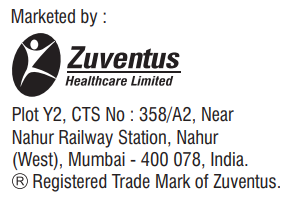
About leaflet
Read all of this leaflet carefully before you start taking this medicine because it contains important information for you.
- Keep this leaflet. You may need to read it again.
- If you have any further questions, ask your doctor, pharmacist, or nurse.
- This medicine has been prescribed for you only. Do not pass it on to others. It may harm them, even if their signs of illness are the same as yours.
- If you get any side effects, talk to your doctor, pharmacist or nurse. This includes any possible side effects not listed in this leaflet. See section 4.
What is in this leaflet
- What Zensita M is and what it is used for
- What you need to know before you take Zensita M
- How to take Zensita M
- Possible side effects
- How to store Zensita M
- Contents of the pack and other information
1. What Zensita M is and what it is used for
Zensita M contains two different medicines called sitagliptin and metformin.
- sitagliptin belongs to a class of medicines called DPP-4 inhibitors (dipeptidyl peptidase-4 inhibitors)
- metformin belongs to a class of medicines called biguanides.
They work together to control blood sugar levels in adult patients with a form of diabetes called ‘type 2 diabetes mellitus’. This medicine helps to increase the levels of insulin produced after a meal and lowers the amount of sugar made by your body.
Along with diet and exercise, this medicine helps lower your blood sugar. This medicine can be used alone or with certain other medicines for diabetes (insulin, sulphonylureas, or glitazones).
What is type 2 diabetes?
Type 2 diabetes is a condition in which your body does not make enough insulin, and the insulin that your body produces does not work as well as it should. Your body can also make too much sugar.
When this happens, sugar (glucose) builds up in the blood. This can lead to serious medical problems like heart disease, kidney disease, blindness, and amputation.
2. What you need to know before you take Zensita M
Do not take Zensita M
- if you are allergic to sitagliptin or metformin or any of the other ingredients of this medicine (listed in section 6).
- if you have severely reduced kidney function
- if you have uncontrolled diabetes, with e.g. severe hyperglycaemia (high blood glucose), nausea, vomiting, diarrhoea, rapid weight loss, lactic acidosis (see “Risk of lactic acidosis” below) or ketoacidosis. Ketoacidosis is a condition in which substances called ‘ketone bodies’ accumulate in the blood and which can lead to diabetic pre-coma. Symptoms include stomach pain, fast and deep breathing, sleepiness or your breath developing an unusual fruity smell.
- if you have a severe infection or are dehydrated
- if you are going to have an X-ray where you will be injected with a dye. You will need to stop taking Zensita M at the time of the X-ray and for 2 or more days after as directed by your doctor, depending on how your kidneys are working
- if you have recently had a heart attack or have severe circulatory problems, such as ‘shock’ or breathing difficulties
- if you have liver problems
- if you drink alcohol to excess (either every day or only from time to time)
- if you are breast-feeding
Do not take Zensita M if any of the above apply to you and talk with your doctor about other ways of managing your diabetes. If you are not sure, talk to your doctor, pharmacist or nurse before taking Zensita M.
Warnings and precautions
Cases of inflammation of the pancreas (pancreatitis) have been reported in patients receiving Zensita M (see section 4).
If you encounter blistering of the skin it may be a sign for a condition called bullous pemphigoid.
Your doctor may ask you to stop Zensita M.
Risk of lactic acidosis
Zensita M may cause a very rare, but very serious side effect called lactic acidosis, particularly if your kidneys are not working properly. The risk of developing lactic acidosis is also increased with uncontrolled diabetes, serious infections, prolonged fasting or alcohol intake, dehydration (see further information below), liver problems and any medical conditions in which a part of the body has a reduced supply of oxygen (such as acute severe heart disease).
If any of the above apply to you, talk to your doctor for further instructions.
Stop taking Zensita M for a short time if you have a condition that may be associated with dehydration (significant loss of body fluids) such as severe vomiting, diarrhoea, fever, exposure to heat or if you drink less fluid than normal. Talk to your doctor for further instructions.
Stop taking Zensita M and contact a doctor or the nearest hospital immediately if you experience some of the symptoms of lactic acidosis, as this condition may lead to coma.
Symptoms of lactic acidosis include:
- vomiting
- stomach ache (abdominal pain)
- muscle cramps
- a general feeling of not being well with severe tiredness
- difficulty in breathing
- reduced body temperature and heartbeat
Lactic acidosis is a medical emergency and must be treated in a hospital. Talk to your doctor or pharmacist before taking Zensita M:
- if you have or have had a disease of the pancreas (such as pancreatitis)
- if you have or have had gallstones, alcohol dependence or very high levels of triglycerides (a form of fat) in your blood. These medical conditions can increase your chance of getting pancreatitis (see section 4)
- if you have type 1 diabetes. This is sometimes called insulin-dependent diabetes
- if you have or have had an allergic reaction to sitagliptin, metformin, or Zensita M (see section 4)
- if you are taking a sulphonylurea or insulin, diabetes medicines, together with Zensita M, as you may experience low blood sugar levels (hypoglycaemia). Your doctor may reduce the dose of your sulphonylurea or insulin.
If you need to have major surgery you must stop taking Zensita M during and for some time after the procedure. Your doctor will decide when you must stop and when to restart your treatment with Zensita M.
If you are not sure if any of the above apply to you, talk to your doctor or pharmacist before taking Zensita M.
During treatment with Zensita M, your doctor will check your kidney function at least once a year or more frequently if you are elderly and/or if you have worsening kidney function.
Children and adolescents
Children and adolescents below 18 years should not use this medicine. It is not effective in children and adolescents between the ages of 10 and 17 years. It is not known if this medicine is safe and effective when used in children younger than 10 years.
Other medicines and Zensita M
If you need to have an injection of a contrast medium that contains iodine into your bloodstream, for example, in the context of an X-ray or scan, you must stop taking Zensita M before or at the time of the injection. Your doctor will decide when you must stop and when to restart your treatment with Zensita M.
Tell your doctor or pharmacist if you are taking, have recently taken or might take any other medicines. You may need more frequent blood glucose and kidney function tests, or your doctor may need to adjust the dosage of Zensita M. It is especially important to mention the following:
- medicines (taken by mouth, inhalation, or injection) used to treat diseases that involve inflammation, like asthma and arthritis (corticosteroids)
- medicines which increase urine production (diuretics)
- medicines used to treat pain and inflammation (NSAID and COX-2-inhibitors, such as ibuprofen and celecoxib)
- certain medicines for the treatment of high blood pressure (ACE inhibitors and angiotensin II receptor antagonists)
- specific medicines for the treatment of bronchial asthma (β-sympathomimetics)
- iodinated contrast agents or alcohol-containing medicines
- certain medicines used to treat stomach problems such as cimetidine
- ranolazine, a medicine used to treat angina
- dolutegravir, a medicine used to treat HIV infection
- vandetanib, a medicine used to treat a specific type of thyroid cancer (medullary thyroid cancer)
- digoxin (to treat irregular heartbeat and other heart problems). The level of digoxin in your blood may need to be checked if taking with Zensita M.
Zensita M with alcohol
Avoid excessive alcohol intake while taking Zensita M since this may increase the risk of lactic acidosis (see section “Warnings and precautions”).
Pregnancy and breast-feeding
If you are pregnant or breast-feeding, think you may be pregnant or are planning to have a baby, ask your doctor or pharmacist for advice before taking this medicine. You should not take this medicine during pregnancy or if you are breast-feeding. See section 2, Do not take Zensita M.
Driving and using machines
This medicine has no or negligible influence on the ability to drive and use machines. However, dizziness and drowsiness have been reported with sitagliptin, which may affect your ability to drive or use machines.
Taking this medicine in combination with medicines called sulphonylureas or with insulin can cause hypoglycaemia, which may affect your ability to drive and use machines or work without safe foothold.
Zensita M contains sodium.
This medicine contains less than 1 mmol sodium (23 mg) per tablet, that is to say essentially ‘sodium free’.
3. How to take Zensita M
Always take this medicine exactly as your doctor has told you. Check with your doctor or pharmacist if you are not sure.
- Take one tablet:
- twice daily by mouth
- with meals to lower your chance of an upset stomach.
- Your doctor may need to increase your dose to control your blood sugar.
- If you have reduced kidney function, your doctor may prescribe a lower dose.
You should continue the diet recommended by your doctor during treatment with this medicine and take care that your carbohydrate intake is equally distributed over the day.
This medicine alone is unlikely to cause abnormally low blood sugar (hypoglycaemia). When this medicine is used with a sulphonylurea medicine or with insulin, low blood sugar can occur and your doctor may reduce the dose of your sulphonylurea or insulin.
If you take more Zensita M than you should
If you take more than the prescribed dosage of this medicine, contact your doctor immediately. Go to the hospital if you have symptoms of lactic acidosis such as feeling cold or uncomfortable, severe nausea or vomiting, stomach ache, unexplained weight loss, muscular cramps, or rapid breathing (see section “Warnings and precautions”).
If you forget to take Zensita M
If you miss a dose, take it as soon as you remember. If you do not remember until it is time for your next dose, skip the missed dose and go back to your regular schedule. Do not take a double dose of this medicine.
If you stop taking Zensita M
Continue to take this medicine as long as your doctor prescribes it so you can continue to help control your blood sugar. You should not stop taking this medicine without talking to your doctor first. If you stop taking Zensita M, your blood sugar may rise again.
If you have any further questions on the use of this medicine, ask your doctor or pharmacist.
4. Possible side effects
Like all medicines, this medicine can cause side effects, although not everybody gets them.
STOP taking Zensita M and contact a doctor immediately if you notice any of the following serious side effects:
Severe and persistent pain in the abdomen (stomach area) which might reach through to your back with or without nausea and vomiting, as these could be signs of an inflamed pancreas (pancreatitis).
Zensita M may cause a very rare (may affect up to 1 in 10,000 people), but very serious side effect called lactic acidosis (see section “Warnings and precautions”). If this happens, you must stop taking Zensita M and contact a doctor or the nearest hospital immediately, as lactic acidosis may lead to coma.
If you have a serious allergic reaction (frequency not known), including rash, hives, blisters on the skin/peeling skin and swelling of the face, lips, tongue, and throat that may cause difficulty in breathing or swallowing, stop taking this medicine and call your doctor right away. Your doctor may prescribe a medicine to treat your allergic reaction and a different medicine for your diabetes.
Some patients taking metformin have experienced the following side effects after starting sitagliptin:
Common (may affect up to 1 in 10 people): low blood sugar, nausea, flatulence, vomiting
Uncommon (may affect up to 1 in 100 people): stomach ache, diarrhoea, constipation, drowsiness.
Some patients have experienced diarrhoea, nausea, flatulence, constipation, stomach ache or vomiting when starting the combination of sitagliptin and metformin together (frequency is common).
Some patients have experienced the following side effects while taking this medicine with a sulphonylurea such as glimepiride:
Very common (may affect more than 1 in 10 people): low blood sugar
Common: constipation
Some patients have experienced the following side effects while taking this medicine in combination with pioglitazone:
Common: swelling of the hands or legs
Some patients have experienced the following side effects while taking this medicine in combination with insulin
Very common: low blood sugar
Uncommon: dry mouth, headache
Some patients have experienced the following side effects during clinical studies while taking sitagliptin alone (one of the medicines in Zensita M) or during post-approval use of Zensita M or sitagliptin alone or with other diabetes medicines:
Common: low blood sugar, headache, upper respiratory infection, stuffy or runny nose and sore throat, osteoarthritis, arm or leg pain
Uncommon: dizziness, constipation, itching
Rare: reduced number of platelets
Frequency not known: kidney problems (sometimes requiring dialysis), vomiting, joint pain, muscle pain, back pain, interstitial lung disease, bullous pemphigoid (a type of skin blister)
Some patients have experienced the following side effects while taking metformin alone:
Very common: nausea, vomiting, diarrhoea, stomach ache and loss of appetite. These symptoms may happen when you start taking metformin and usually go away
Common: a metallic taste
Very rare: decreased vitamin B12 levels, hepatitis (a problem with your liver), hives, redness of the skin (rash) or itching
Reporting of side effects
If you get any side effects, talk to your doctor. This includes any possible side effects not listed in this leaflet. You can also report side effects directly: Website: www.zuventus.co.in and click the tab “Safety Reporting” located on the top right end of the home page.
By reporting side effects, you can help provide more information on the safety of this medicine.
5. How to store Zensita M
- Keep this medicine out of the sight and reach of children.
- Do not use this medicine after the expiry date which is stated on the blister and the carton after 'EXP'.
- The expiry date refers to the last day of the month.
- Do not store above 30°C.
- Do not throw away any medicines via wastewater or household waste. Ask your pharmacist how to throw away medicines you no longer use. These measures will help protect the environment.
6. Contents of the pack and other information
What Zensita M contains
- The active substances are sitagliptin and metformin.
- Each Zensita M 50 mg/500 mg film-coated tablet (tablet) contains sitagliptin phosphate monohydrate equivalent to 50 mg of sitagliptin and 500 mg of metformin hydrochloride
- Each Zensita M 50 mg/1,000 mg film-coated tablet (tablet) contains sitagliptin phosphate monohydrate equivalent to 50 mg of sitagliptin and 1,000 mg of metformin hydrochloride.
Marketing Authorisation Holder
Zuventus Heathcare Ltd.
Kamerey Bhasmay, Elaka Pakyong,
Rangpo, East-Sikkim 737 132, India.
This leaflet was last revised in June 2023.

